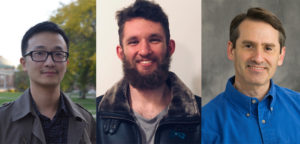Tianjiong (Yves) Yao was born in Shanghai, China in 1987. He received his B.S. and Engineer degrees in bioengineering from University of Technology of Compiègne (UTC) in 2012. He received his M.S. degree in molecular and cellular biology at Brandeis University in 2015, where he worked with Lizbeth Hedstrom. He joined the University of Illinois at Urbana-Champaign as a Ph.D. student in biochemistry in 2015. In the laboratory of Prof. Scott K. Silverman he studies DNAzymes, focusing on amine and peptide lysine acylation reactions. Outside of the lab, he is a big fan of horror movies and cannot resist cute kittens.
Jack J. Przybyla was born in Baltimore, Maryland, USA in 1997. He received his B.S. degree in biochemistry from Michigan State University in 2019. He joined the University of Illinois at Urbana-Champaign as a Ph.D. student in biochemistry in 2019. In the laboratory of Prof. Scott K. Silverman he studies DNAzymes, focusing on amine and peptide lysine acylation reactions. Outside of the lab, he spends his time writing up outlines for creative projects that he has still yet to finish.
Scott K. Silverman was born in Los Angeles, California, USA in 1972. He received his B.S. from UCLA in 1991 working with Christopher Foote on photooxygenation mechanisms and his Ph.D. from Caltech in 1997 working with Dennis Dougherty on high-spin organic polyradicals and molecular neurobiology. After postdoctoral research on RNA folding at University of Colorado Boulder with Thomas Cech, he joined the faculty at University of Illinois at Urbana-Champaign in 2000, where he is Professor of Chemistry. His research group uses in vitro selection to identify DNAzymes with new catalytic activities. Outside of research, he runs, lifts weights, and reads far too much about penguins.
What inspired your research in this area?
We are interested in DNAzymes as artificial enzymes identified de novo without needing a natural starting point. In vitro selection from random sequence populations isn’t possible for proteins, so we use nucleic acids, specifically DNA for its favourable practical properties relative to RNA. Amine (lysine) acylation is an important biological regulatory modification, and new amine-acylating DNAzymes could open the door to useful site-specific peptide and protein modification reactions.
What do you personally feel is the most interesting outcome of your study?
Showing that DNAzymes have the fundamental capability to catalyze amine acylation with high rate enhancement (we observed up to 1000-fold) is an exciting fundamental advance in catalysis by biologically related molecules.
What directions are you planning to take with your research in future?
The longer-term goal of the research in this article is to identify DNAzymes that can site-specifically modify particular lysine residues in folded proteins. This is an ambitious goal, with many challenges that still remain to be addressed. We are excited that we have established the fundamental catalytic capability, and now we have to get this to work with proteins.
Read the full article: DNAzymes for amine and peptide lysine acylation
See the other articles showcased in this month’s Editor’s Collection
See all the full articles on our publishing platform











